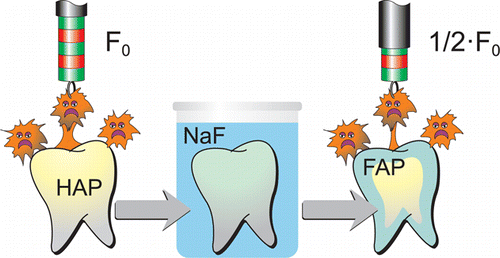New evidence on how fluoride fights tooth decay

In an advance toward solving a 50-year-old mystery, scientists are reporting new evidence on how the fluoride in drinking water, toothpastes, mouth rinses and other oral-care products prevents tooth decay. Their report appears in the ACS journal Langumir.
Karin Jacobs and colleagues explain that despite a half-century of scientific research, controversy still exists over exactly how fluoride compounds reduce the risk of tooth decay. That research established long ago that fluoride helps to harden the enamel coating that protects teeth from the acid produced by decay-causing bacteria. Newer studies already found that fluoride penetrates into and hardens a much thinner layer of enamel than previously believed, lending credence to other theories about how fluoride works.
The report describes new evidence that fluoride also works by impacting the adhesion force of bacteria that stick to the teeth and produce the acid that causes cavities. The experiments—performed on artificial teeth (hydroxyapatite pellets) to enable high-precision analysis techniques—revealed that fluoride reduces the ability of decay-causing bacteria to stick, so that also on teeth, it is easier to wash away the bacteria by saliva, brushing and other activity.
More information: Reduced Adhesion of Oral Bacteria on Hydroxyapatite by Fluoride Treatment, Langmuir, Article ASAP DOI: 10.1021/la4008558
Abstract
The mechanisms of action of fluoride have been discussed controversially for decades. The cavity-preventive effect for teeth is often traced back to effects on demineralization. However, an effect on bacterial adhesion was indicated by indirect macroscopic studies. To characterize adhesion on fluoridated samples on a single bacterial level, we used force spectroscopy with bacterial probes to measure adhesion forces directly. We tested the adhesion of Streptococcus mutans, Streptococcus oralis, and Staphylococcus carnosus on smooth, high-density hydroxyapatite surfaces, pristine and after treatment with fluoride solution. All bacteria species exhibit lower adhesion forces after fluoride treatment of the surfaces. These findings suggest that the decrease of adhesion properties is a further key factor for the cariostatic effect of fluoride besides the decrease of demineralization.
Journal information: Langmuir
Provided by American Chemical Society
















